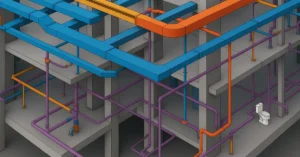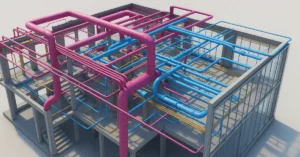Revolutionizing Architecture: The Synergy of Project Blending with AI in Architecture

In the dynamic realm of architecture, innovation is the cornerstone of progress. Architects continually seek new methodologies to transcend boundaries, blend diverse elements, and create spaces that seamlessly integrate with their surroundings. One such groundbreaking approach that is redefining the architectural landscape is project blending with AI. This innovative process harnesses the power of artificial intelligence to amalgamate architectural elements, styles, and environments, ushering in a new era of creativity, efficiency, and sustainability.
Understanding Project Blending in Architecture:
Project blending epitomizes the fusion of imagination and technology, offering architects a novel framework to weave together disparate design elements into a cohesive whole. At its essence, project blending transcends conventional boundaries, enabling architects to harmonize historical traditions with contemporary innovations, seamlessly integrate sustainable features, and ensure architectural interventions resonate harmoniously with their environments.
The Evolution of AI in Architecture:
The integration of artificial intelligence into architectural practice marks a significant paradigm shift, empowering architects to leverage cutting-edge tools and techniques to augment their design processes. AI algorithms, such as those utilized by platforms like Midjourney, analyze vast datasets of architectural designs, identifying patterns, trends, and possibilities that may elude human perception. This symbiotic relationship between AI and architecture transcends traditional design methodologies, fostering a collaborative environment where human creativity converges with computational prowess.
The Role of AI in Project Blending:
AI serves as a catalyst for innovation in project blending, offering architects a repertoire of tools and capabilities to reimagine architectural design. By harnessing AI-driven algorithms, architects can explore a myriad of design permutations, experiment with diverse architectural languages, and seamlessly integrate contextual considerations into their projects. AI platforms like Midjourney facilitate the generation of initial design concepts, providing architects with a springboard to embark on their creative journey.
Step-by-Step Guide to AI-Assisted Project Blending:
- Initial Concept Generation:
Begin by articulating the project’s objectives, delineating the desired synthesis of architectural elements, styles, and environmental considerations. Employ AI to generate preliminary design concepts based on these parameters, leveraging the platform’s computational capabilities to explore diverse design possibilities. - Refinement with Professional Software:
Transition the AI-generated concepts into professional design software such as Photoshop or SketchUp for further refinement. Here, architects can fine-tune the design elements, iterate on spatial configurations, and tailor the project to meet specific functional, aesthetic, and contextual requirements. - Integration of Detailed Design Elements:
Infuse the design with bespoke details, material specifications, and structural considerations that encapsulate the project’s unique identity. While AI offers invaluable insights into design synthesis, human intervention remains paramount in articulating nuanced design decisions and imbuing projects with a sense of craftsmanship and authenticity. - Final Visualization and Presentation:
Merge the refined design with realistic environments, contextual settings, or virtual landscapes using AI-generated backgrounds or contextual overlays. This final visualization serves as a compelling narrative that articulates the project’s vision, contextual fit, and design intent to stakeholders, clients, and regulatory bodies.
Benefits of AI-Assisted Project Blending:
- Fostered Innovation:
AI-driven project blending fosters a culture of innovation, encouraging architects to explore uncharted design territories and conceive novel solutions that transcend conventional paradigms. - Streamlined Design Processes:
By automating repetitive tasks and accelerating design iterations, AI expedites the conceptualization and development phases of architectural projects, enabling architects to realize their visions more efficiently. - Enhanced Contextual Integration:
AI facilitates the seamless integration of architectural interventions within their contextual milieu, ensuring that projects resonate harmoniously with their surroundings and contribute positively to their urban fabric.
Challenges and Ethical Considerations:
While the integration of AI in project blending offers unprecedented opportunities for architectural innovation, it also necessitates a nuanced consideration of ethical implications and societal responsibilities. Architects must navigate issues pertaining to cultural heritage preservation, environmental sustainability, and equitable design practices, ensuring that their projects uphold ethical standards and foster inclusive, resilient communities.
Conclusion:
Project blending with AI represents a transformative paradigm shift in architectural practice, heralding a future where human creativity converges with computational intelligence to conceive visionary built environments. By embracing this synergistic approach, architects can unlock new realms of creativity, efficiency, and sustainability, shaping a built environment that embodies the aspirations, values, and cultural narratives of our time. As we venture into this uncharted territory, let us embark on a collective journey of exploration, innovation, and discovery, reimagining the boundaries of architecture and shaping a world that is as inspiring as it is inclusive.
If you’re interested in learning more about architecture firms in Europe, check out this comprehensive list of the top 50 firms compiled by Archgyan. From innovative startups to long-established industry leaders, this list has it all. Take a look and discover some of the most inspiring and influential architecture firms in Europe today.
If you’re interested in architecture and want to learn more about this amazing field, subscribe to our podcast on youtube
For more SketchUp tutorials, head to https://www.sketchupguru.com










